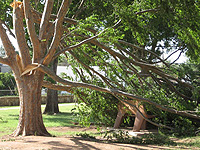 |
||
Ron’s ArticlesFirst aid for trees before you call 911June 2009
But it might be the worst place for you! If you do not properly maintain and nourish your trees some of the most valuable components of your investment in your home, you and your family could be in danger. In my 25 years as a professional firefighter I have learned this lesson too often. I am the one who shows up to see first hand the devastation when a tree crashes through the roof usually in the middle of the night. When we get the call we always hope that we'll be dealing just with property damage. But all too often we have to deal with serious personal injuries even death. Each time our fire truck pulled away from a fallen tree incident, my inquisitive mind would go into action. I just couldn't help wondering, Why did that particular tree blow over? Invariably there were other trees nearby that were still standing. These experiences inspired me to study trees - to become a certified aborist. Now I hope I can save your home, and perhaps life, by saving your trees. If you aren't following proper tree procedures, you are your trees' biggest pest! Here are my recommendations. 1. Trim trees only as needed.Get qualified help. Trimming a tree never benefits the tree. Every leaf is like a solar cell capturing energy from the sun and carbon dioxide from the air to make energy to feed the tree and its roots. But there are times that you must trim a tree. Hire a licensed arborist. I can't tell you how many trees I destroyed in my pre-arborist wood butcher days. And a butcher is what you're getting if you hire some guy who shows up at your door with a chainsaw. 2. Turn off your automatic sprinkler or at least back off the water.Most of our native trees need only 25- 35 inches of water a year. Our rain fall averages 35 inches annually. When you combine this with about 70 inches our automatic sprinklers supply that's 3 to 4 times the amount of water trees need. We are drowning our trees, robbing the soil of carbon, killing beneficial microbes and restricting the healthy root growth that is required to provide stability for the tree. Over-watering also increases disease and insect problems. 3. Never use synthetic fertilizers.At the big box store you can buy a bag of synthetic fertilizer that is labeled with an NPK of 15-5-15. That means it contains, by weight, 15% elemental nitrogen (N) , 5% elemental phosphorus (P), and 15% elemental potassium (K) for a total of 35% of the weight of the bag. What makes up the other 65% of the material in the bag? That would be salts and other toxic waste that is labeled inert material. Those salts destroy the microbial life in the soil. That microbial life is essential to the health of trees. When you buy organic fertilizer, you are applying 100% beneficial natural material to your landscape. 4. Inspect and respect your grade level.Let's start at the tree trunk. It should not go into the soil like a telephone pole. There should be a distinct flare. If not, living trunk tissue that is supposed to be exposed to the air will eventually deteriorate. An arborist can safely clear away excess soil with an airspade. Properly maintained trees add significant value to your property - comfort and enjoyment. Improperly maintained trees are a liability. Following these four simple recommendations will substantially improve the health of your trees and reduce the chances that I'll have to show up during some storm to rescue you and your loved ones. 
|
|
|


|
||
